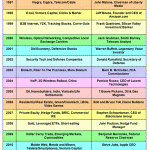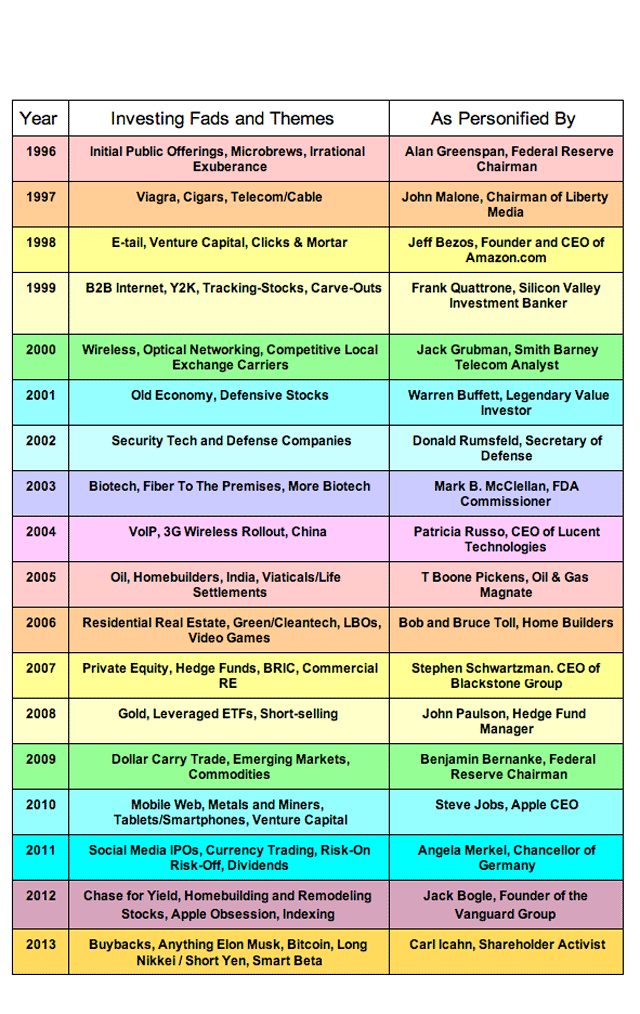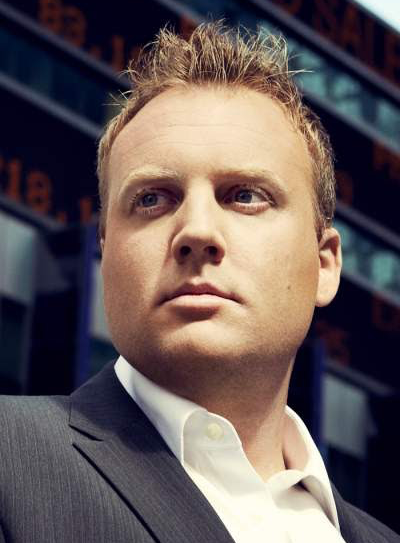 Another year in the books and I’ve updated my Investing Fads and Themes by Year guide accordingly.
Another year in the books and I’ve updated my Investing Fads and Themes by Year guide accordingly.
It begins with 1996 because that was my first summer working on The Street and my earliest exposure to the market. I do this every December because I agree with the eminent philosopher Bob Marley when he reminds us “If you know your history, then you would know where you’re coming from.” If we don’t keep tabs and learn from the lunacy that grips us from year to year, then how can we truly say that we’ve grown as investors?
By documenting this stuff, it becomes a permanent part of my knowledge base, a reference to draw from in times to come as we see similar trends play themselves out and the great wheel spins past an endless parade of fear and greed.
So what was 2013 about?
I would point to six different fads and themes that were very diverse but equally captivating for the investment community.
Elon Musk Stocks
First, let’s talk about Elon Musk, the man with not one publicly-traded rocket ship but two – both Tesla Motors and Solar City were among the hottest stocks in the market in a year of very hot stocks overall. The trading action in Musk-related companies was more exciting than the Facebook rebirth, the Twitter IPO or the 3D Printing explosion.
TSLA began the year as a “concept” stock with a handful of cars on the road and all kinds of doubt about its balance sheet, manufacturing capabilities, sales strategy and whether or not anyone would actually want a Model S to begin with. But boy did they ever. Other than a negative review in the New York Times, the news was pretty much all good and investors were quick to react. Tesla traded from $35 at the beginning of the year to as high as $180 a share, mostly in a straight line, and the chattering classes on The Street simply could not stop talking about. It’s gain year-to-date is a scorching 312% and it currently sports a market cap of $17 billion – to put that into perspective, that’s 30% of GM’s market cap ($55 billion) and Tesla has sold less than 20,000 cars cumulatively since its incorporation!
Elon Musk’s other public company, Solar City, was also no slouch thanks to a new business model (solar panel leasing) and a resurgence in the solar sector in general. SCTY came public one year ago in the dead of December 2012. It is up 328% thus far this year, more than double the global solar stocks’ index return of 142% over the same time frame.
To call Elon Musk-related stocks a major fad this year would be an understatement, the man literally became a real-life Tony Stark right before our eyes and everyone wanted in.
Smart Beta
Last year investors rediscovered index funds and passively managed investments – but the problem with that is there’s no way for fund companies to really make money with indexes unless they’re part of the big three (iShares, State Street or Vanguard) and have massive scale. Enter the concept of “Smart Beta.” This is the idea that fundamentally-weighted indexes could be created and then ETF’d, the products themselves garnering a higher internal fee justified by historical outperformance vs plain-vanilla cap-weighted products like SPY or QQQ.
And so we saw dividend funds proliferate along with earnings-driven indexes and shareholder yield products (dividends plus buybacks) and “AlphaDex” products and dividend growth indexes and quality screen indexes and equal-weight indexes and dozens of offerings based on just about any way you could slice or dice a passive basket of stocks. BlackRock’s suite of minimum-volatility index ETFs took in an astonishing $2.6 billion of new assets in the first half of 2013 versus just $745 million through all of 2012. According to Cogent Research, smart beta or non-market cap weighted ETFs have captured 25% of the equity ETF inflows year to date, despite representing only 12% of the industry’s assets.
The idea of fundamentally-weighted indexes is not new – Rob Arnott’s Research Affiliates invented it years ago (whenever you see the term RAFI in the fund product, that’s them) and WisdomTree has essentially built its ETF empire based on the concept. But this year, thousands of professional portfolio managers became self-styled “beta managers”. Rich Bernstein, a high visibility strategist and money manager who was in the vanguard of this trend, blew through the $1 billion AUM mark this past spring managing nothing but portfolios of smart beta allocations.
Recently, detractors from the quant universe like Cliff Asness (AQR) and James Montier (GMO) have taken on the idea of so-called smart beta, calling it “snake oil sold in new bottles.” Even the godfather of the concept, Rob Arnott, in a research paper published at the Journal of Portfolio Management, pointed out the fact that virtually all of the success of these strategies can be boiled down to their exposure to the small cap premium and the value stock premium – two of the oldest and most well-known anomalies in all of finance.
Long Nikkei / Short Yen
When incoming Japanese Prime Minister Shinzo Abe announced his sweeping economic reform policies at the end of 2012, most US investors were not paying attention – and why should they? Japanese stocks, after all, had been in a bear market for almost a quarter of a century – every sputtering rally over the years has led to further disappointment and heartbreak. But this time, something was different. The sheer scale of the thing being attempted was massive, a stimulus three times what Bernanke & Co were pursuing stateside, a reformation involving everything from currency debasement to workplace sexual politics to the outright ope-market purchases of not only Japanese bonds, but Japanese stocks, REITs and ETFs as well by the Bank of Japan.
This was some next-level shit and the hedge funds that were paying attention got really big in their long Nikkei / short yen pairs trade. But unlike the major macro trends of the past, this theme also had a ready-to-wear solution for retail investors to play along – and play they did! WisdomTree’s Japan Hedged Equity ETF, colloquially known by its ticker symbol DXJ, was perhaps the most perfectly situated strategy ETF of all time. After the fund sat like a log for a few years, the WisdomTree team hit upon the idea of converting it to a long-Japanese stocks, short Japanese currency vehicle in the summer of 2012 – just in time! And then the Abenomics cannons went boom and the dollars came flooding in over the transom.
According to Index Universe, DXJ was the number one asset-gathering ETF of 2013, pulling in almost $8.7 billion in net inflows during the first 11 months of this year. Being long the Japanese market while being hedged against the yen was the hottest trade of the year, no matter how people wanted to express it.
Bitcoin
Last October, a tiny start-up based on the Island of Malta called Exante Ltd launched the first-ever Bitcoin Hedge Fund. If you didn’t hear about it at the time, it’s probably because the crypto-currency was still relatively unknown in the mainstream and its meteoric price rise hadn’t begun yet. Bitcoin, a virtual currency requiring computer-powered mining and most often used for anonymous drug dealing and smuggling, was only changing hands at $14 per unit. In the eyes of the media, it was regarded as being somewhere between a geek’s plaything and a technocrat’s wet dream. And then all of a sudden, the price of Bitcoin took off, concurrent with the public’s discovery of its potential as both a currency and a vehicle for speculation.
It’s still hard to distinguish what happened first – the mass awareness or the rise in price – but, in truth, the two things probably fed off of each other. Investment vehicles and exchanges came along to give traders an outlet for their enthusiasm and a way into the game. The price of Bitcoin had shot up to a record $1200 and the Exante hedge fund reported an annual return of 4,847% by the end of November – the biggest one-year hedge fund return in world history.
As of this writing, every single mainstream publication, periodical, website and news program has featured the Bitcoin phenomenon and there are already a handful of competing crypto-currencies coming out of the woodwork. And while the price is up some 10,000% this year, something tells me the investor class’s infatuation has only just begun.
Buybacks
By far, the most important trend in investing this year was the anticipation and celebration of stock repurchases or share buybacks – the fuel that powered both corporate earnings growth and the ascent of the stock market. As some columnists have put it, the US stock market spent most of the year literally shrinking! Despite a record year for IPOs, the sheer scale of stock buybacks meant less and less shares to go around. The supply-demand dynamics work the same way in the stock market as they do in any other aspect of business and the effect of this scarcity condition have been amazing for investors.
According to FactSet Research, S&P 500 companies repurchased an total of $415 billion worth of their own stock this year, up 12% from 2012. Apple alone authorized a $60 billion repurchase plan, the largest such endeavor of all time, and it’s probably what finally but a bottom underneath its stock price.
Much of this buyback activity stemmed from an inability or unwillingness to invest their cash – corporate balance sheets came into the year holding $1.2 trillion of it. Managers buying back stock are able to goose earnings, raise dividends for the remaining shares outstanding and avoid the risk of making a lousy investment or acquisition. All of these things juice their compensation and bonus come year-end, so why wouldn’t they shrink their public floats? Executives are aided and abetted in this activity by their shareholders, many of whom are institutions actively seeking yield that they cannot obtain from the bond market. Nothing enables a company to grow its dividend yield like a smaller share count, the two go hand in hand with cash-rich companies.
Carl Icahn: American Badass
And no one is more enamored of the buyback effect than Wall Street’s man of the year, Carl Icahn. A shareholder activist with almost 50 market-moving years under his belt, Icahn probably had the biggest year of his career in 2013. He kicked things off in January with a two-hour televised beatdown of rival hedge fund manager Bill Ackman and proceeded to decapitate anyone in his path all year long. When he wasn’t ringing up billions in profits with Netflix stock, he was driving up the price of Herbalife. This was in between tweeting out messages that literally moved the price of Apple shares, a half-trillion dollar company. Carl was scoring left and right in 2013 and by the end of November, he had surpassed George Soros as the wealthiest hedge fund manager in the world, adding $8 billion in investment gains this year for a total net worth of somewhere around $22 billion.
And then TIME Magazine put him on the cover, calling him “the most important investor in America.” Quite a year for a 77 year old kid from Queens.
***
So those were the big stories of the year that investors and traders bought into. Below is my updated guide to the Investing Fads and Themes by Year, 1996 – 2013. Enjoy!

See previous years below!




[…] 2013 […]
[…] 2013 […]
… [Trackback]
[…] There you can find 86400 additional Info on that Topic: thereformedbroker.com/2013/12/12/investment-fads-and-themes-1996-2013/ […]
… [Trackback]
[…] Here you will find 92284 additional Info to that Topic: thereformedbroker.com/2013/12/12/investment-fads-and-themes-1996-2013/ […]
… [Trackback]
[…] Find More here on that Topic: thereformedbroker.com/2013/12/12/investment-fads-and-themes-1996-2013/ […]
… [Trackback]
[…] Information on that Topic: thereformedbroker.com/2013/12/12/investment-fads-and-themes-1996-2013/ […]
… [Trackback]
[…] Find More on on that Topic: thereformedbroker.com/2013/12/12/investment-fads-and-themes-1996-2013/ […]
… [Trackback]
[…] Information to that Topic: thereformedbroker.com/2013/12/12/investment-fads-and-themes-1996-2013/ […]
… [Trackback]
[…] Find More Information here on that Topic: thereformedbroker.com/2013/12/12/investment-fads-and-themes-1996-2013/ […]
… [Trackback]
[…] There you can find 40497 additional Info to that Topic: thereformedbroker.com/2013/12/12/investment-fads-and-themes-1996-2013/ […]
… [Trackback]
[…] Info on that Topic: thereformedbroker.com/2013/12/12/investment-fads-and-themes-1996-2013/ […]